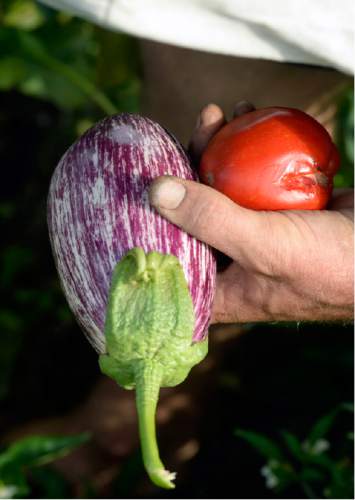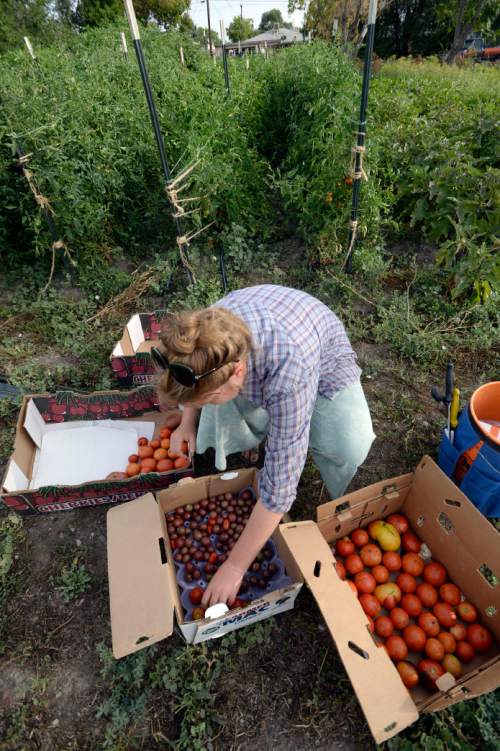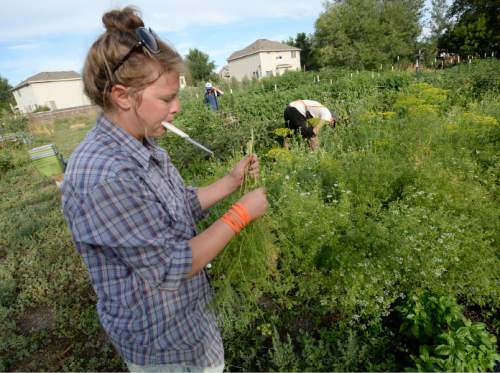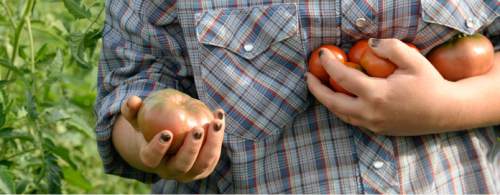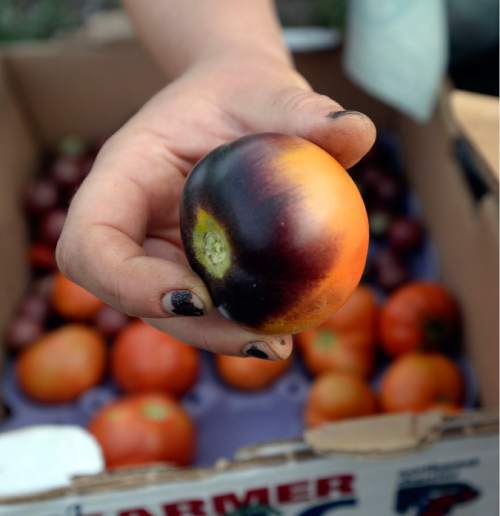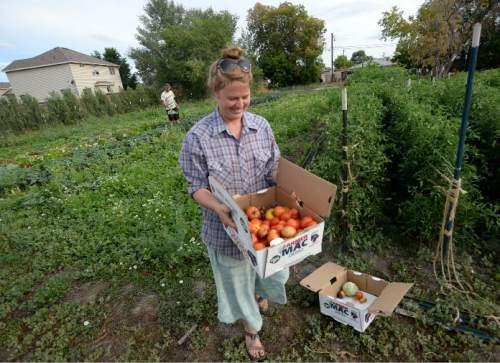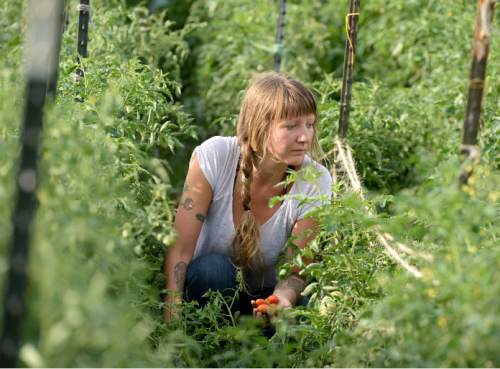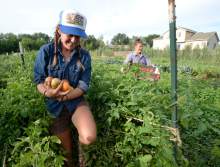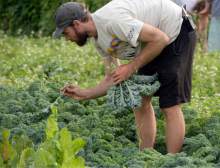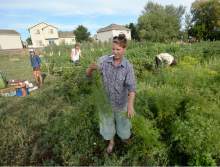This is an archived article that was published on sltrib.com in 2015, and information in the article may be outdated. It is provided only for personal research purposes and may not be reprinted.
Utahns are hungry to be more self-sufficient when it comes to food production. And to satisfy the craving, they want fruit and vegetable crops in the state to increase significantly during the next 30-plus years, a new study by Envision Utah shows.
To help make it happen, 98 percent of Utahns would be willing to cut back on watering their lawns and avoid building on high-quality farmland.
"This is what we've been hearing for some time, that people want food that is safe and locally produced and they want it to be sustainable," said LuAnn Adams, commissioner of the Utah Department of Agriculture and Food.
While Utahns may be willing to do their part, those working in the agriculture industry say reaching the lofty goal will require action on many fronts — from securing agricultural land and training new farmers to encouraging more consumers to shop at farmers markets and eat what's in season.
Currently, most of Utah's agricultural production is in grains and proteins, namely cattle. The state produces 98 percent of the grains and 135 percent of the protein it needs to be self-sufficient, the Envision study shows.
Produce is a different story. Utah grows just 3 percent of the fruits and 2 percent of the vegetables consumed by residents. It also produces 26 percent of its dairy products.
Those numbers are expected to decline even further by 2050, as the population of the state nearly doubles and more farmland and agriculture water are lost to development.
Those who took the Envision survey online were asked what Utah's agricultural landscape should look like in the future. Given four scenarios — ranging from limited development to expansive — an overwhelming majority, or 65 percent, said they wanted to limit development on agricultural land and see Utah eventually produce 20 percent of all its fruits and vegetables and 30 percent of its dairy.
Another 33 percent chose a scenario in which Utah's food self-sufficiency increased to a lesser extent — 10 percent of all fruits and vegetables and 14 percent of dairy.
There are certain areas of the state where growing fruits and vegetables isn't practical because of weather, soil, elevation or lack of available water, said Adams. All the more reason, she said, that state, county and city leaders as well as private entities need to identify current agricultural land and work to preserve at least a portion for the future.
"The land needs to be more than placeholders for subdivisions," she said, adding that conservation easements ensure that farmlands will continue to remain available for agriculture and will not be converted to other uses.
Adams would like to see families have other options, as well.
"We have to think outside of the box and create all kinds of options farmers can look at when they are transitioning their farm to the next generation," she said. "We need to help people feel like selling to a developer is not their only option."
Encouraging young people to become farmers and finding them land to cultivate is an obstacle, said Ashley Patterson, with Wasatch Community Gardens. According to statistics from the U.S. Department of Agriculture, for every one farmer and rancher under age 25, there are five who are 75 or older. The rapidly aging farmer population "is a crisis," she said.
Years ago, most people learned farming from their parents and then took over the family business. Those who may want to farm today don't own land — and can't afford to buy it — discouraging them from entering the field.
"We have to figure out how to get them some land," she said. "The old model of a giant farm is not a model that will work for everyone in the future."
Small, urban "microfarms," like the one operated by Carly Gillespie and Coleman Riedesel, may be the answer.
The co-owners of Backyard Urban Gardens — or BUG Farms — borrow backyard space from homeowners in the Glendale neighborhood of Salt Lake City. In return for sharing the yard, the landowner gets a portion of the produce that is grown. The rest is harvested and sold at farmers markets or delivered to shareholders in BUG Farms' Community Supported Agriculture program.
In all, Gillespie and Riedesel have about 1.25 acres and probably will harvest at least 10,000 pounds of food during the 22-week growing season.
Using drip irrigation systems, cover crops and other proven farming techniques, "it's shocking" to see how much can be produced on a small piece of land, Gillespie said.
Julie Peck-Dabling agrees, saying the future of farming is all about "rethinking scale."
"No more amber waves of grain," said Peck-Dabling, who oversees Salt Lake County's urban farming program. "That's really pretty and may qualify in the Midwest, but not in our environment."
She said Utah doesn't have to reinvent the wheel. In cities across the country, there are rooftop farms, vertical gardening operations as well as green and hoop houses in urban areas.
"It requires a forward-thinking city or county that will allow farming and agriculture in any type of zoning," she said.
The education process extends to consumers, too, said David Bell, owner of Bell Organic Gardens in Draper.
Bell may have one of the most successful CSAs in the Salt Lake Valley, growing food for 200 families, but he has a pet peeve when he takes his produce to farmer markets and patrons are hesitant to buy.
"It's hard to get people to spend money on what is sometimes — but not always — higher-priced food," said Bell. "People look, but they just can't open their wallets."
In the end, he said, "the county and the state can do awesome stuff, but without serious support from the end-consumer, it's tough for small farmers to come back from one year to the next."
kathys@sltrib.com About the survey
A total of 52,845 Utahns took part in the Envision Utah poll, which gauged public sentiment on 11 major topics, including recreation, schools, public lands, air quality, transportation and water use.
Dubbed "Your Utah Your Future," the interactive online survey was buttressed by additional random-sample polling conducted by phone.
Envision Utah CEO Robert Grow said the results are meant as a guide for government policies for decades to come.



